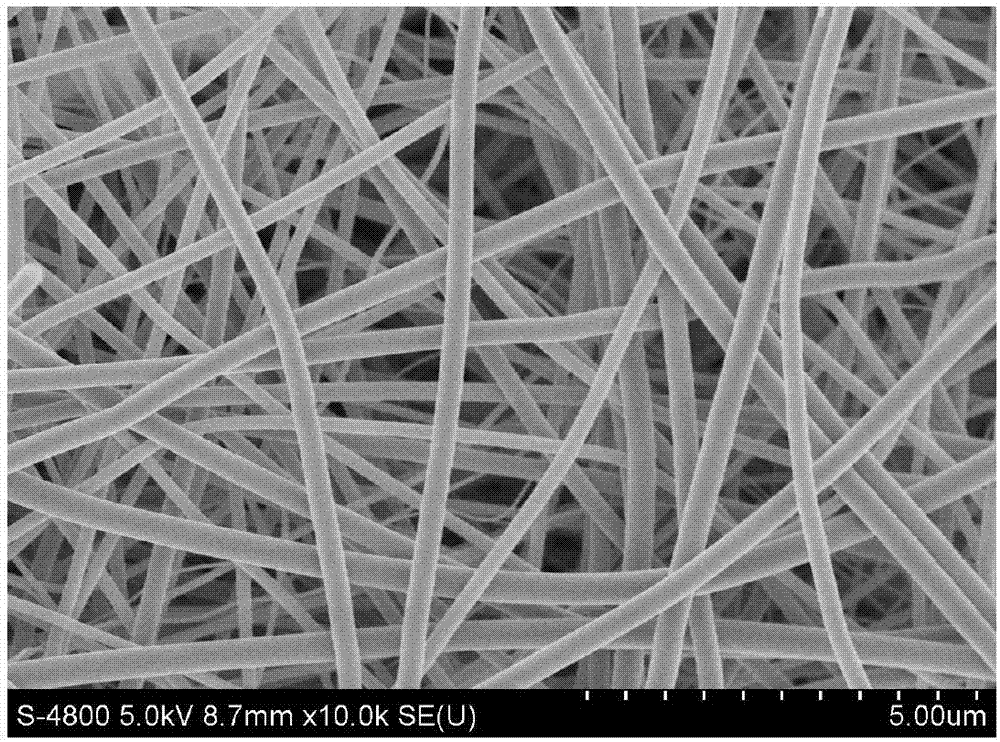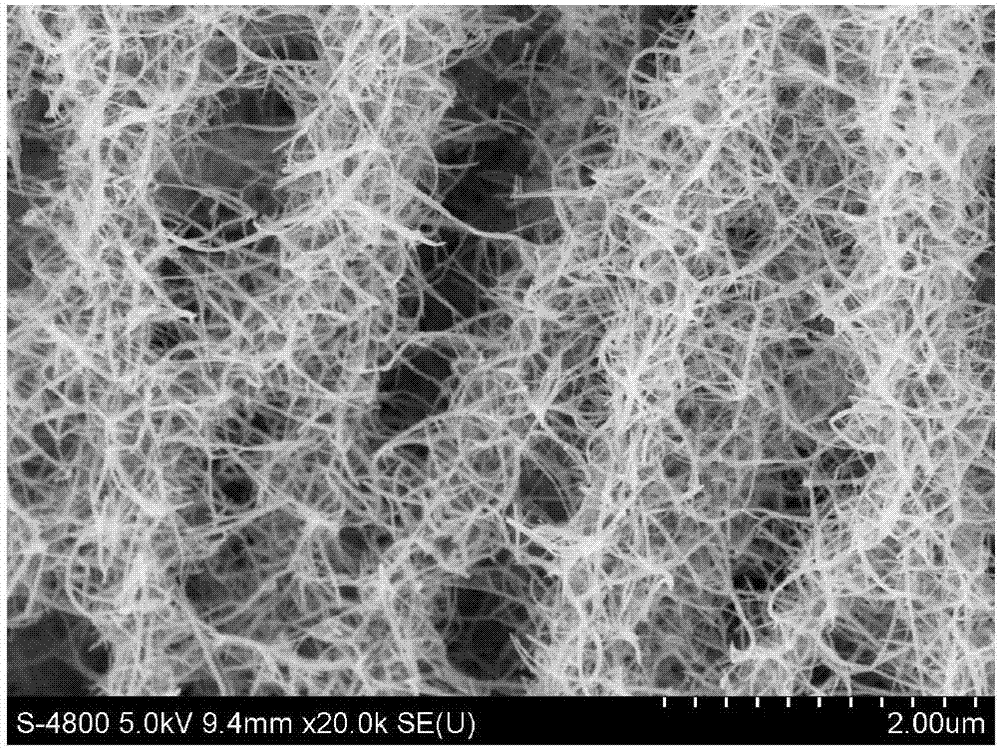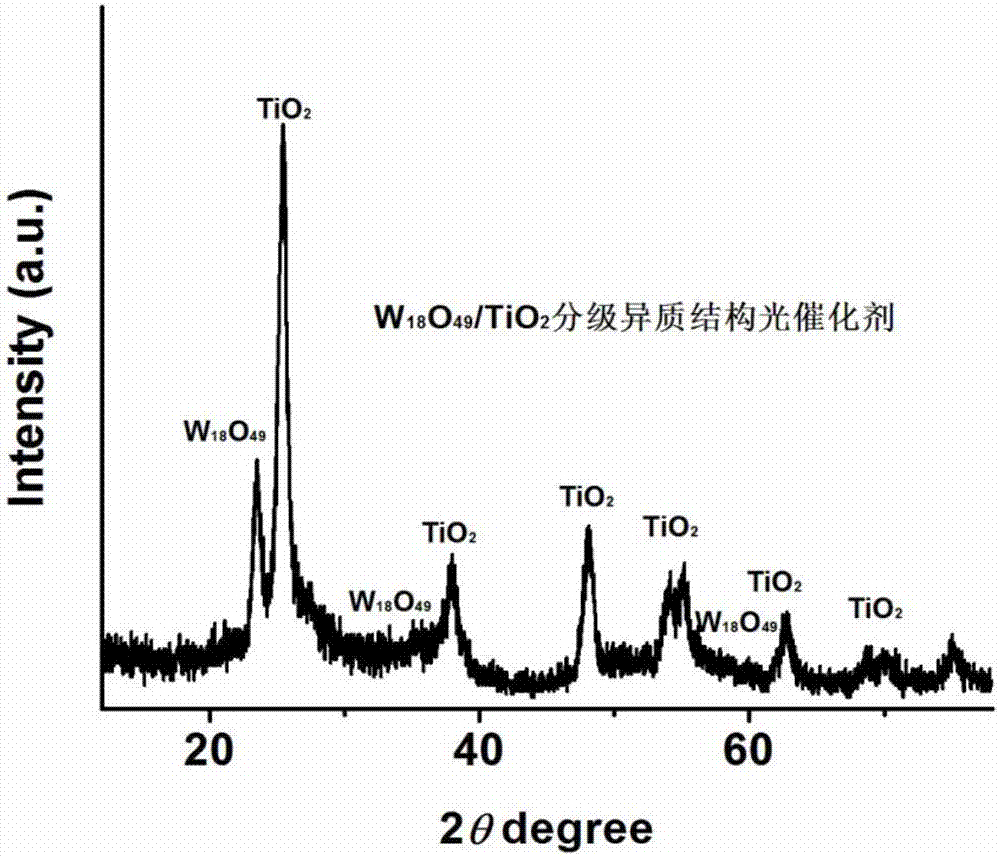Non-stoichiometric tungsten oxide/titanium dioxide hierarchical nano-heterostructure photocatalyst and preparation method
A nano-heterogeneous structure and photocatalyst technology, applied in the direction of physical/chemical process catalysts, chemical instruments and methods, chemical/physical processes, etc., can solve problems such as restricting development, achieve high-efficiency hydrogen production performance, improve light absorption range and Effect of carrier separation efficiency
- Summary
- Abstract
- Description
- Claims
- Application Information
AI Technical Summary
Problems solved by technology
Method used
Image
Examples
Embodiment 1
[0023] 2 ml of glacial acetic acid and 2 ml of butyl titanate were added to 5 ml of absolute ethanol, and then 0.4 g of high molecular weight polyvinyl pyrrolidone was dissolved in the above solution to prepare a butyl titanate / polyvinyl pyrrolidone precursor solution. Next, put the precursor solution into a medical syringe with a nozzle with a diameter of 0.4mm, keep the distance between the nozzle and the grounded receiving plate at 12cm, put the copper electrode into the solution and apply a high voltage of 10KV to perform electrospinning, Preparation of butyl titanate / polyvinylpyrrolidone composite nanofibers. Finally, butyl titanate / polyvinylpyrrolidone composite nanofibers were calcined in a muffle furnace at a rate of 2 °C / min to 500 °C and kept for 2 hours to obtain TiO 2 Nanofibers. Prepared TiO 2 Scanning electron micrographs of nanofibers as figure 1 shown. It can be clearly seen from the figure that the prepared TiO 2 The diameter of the nanofiber is 200-400 n...
Embodiment 2
[0027] 1.5 ml of glacial acetic acid and 1.5 ml of butyl titanate were added to 4 ml of absolute ethanol, and then 0.4 g of polymer polyvinyl pyrrolidone was dissolved in the above solution to prepare a butyl titanate / polyvinyl pyrrolidone precursor solution. Next, put the precursor solution into a medical syringe with a nozzle with a diameter of 0.4mm, keep the distance between the nozzle and the grounded receiving plate at 10cm, put the copper electrode into the solution and apply a high voltage of 11KV to perform electrospinning, Preparation of butyl titanate / polyvinylpyrrolidone composite nanofibers. Finally, butyl titanate / polyvinylpyrrolidone composite nanofibers were calcined in a muffle furnace at a rate of 3 °C / min to 500 °C and kept for 1.5 hours to obtain TiO 2 Nanofibers.
[0028] Add 0.069mmol tungsten hexacarbonyl into 20ml of absolute ethanol, and stir magnetically for 20min to dissolve it. Then, to this solution, add the TiO prepared in step 1) 2 Nanofiber 1...
Embodiment 3
[0030] 2ml of glacial acetic acid and 2ml of butyl titanate were added to 4ml of absolute ethanol, and then 0.4g of polymer polyvinylpyrrolidone was dissolved in the above solution to prepare a butyl titanate / polyvinylpyrrolidone precursor solution. Next, put the precursor solution into a medical syringe with a nozzle with a diameter of 0.4mm, keep the distance between the nozzle and the grounded receiving plate at 12cm, put the copper electrode into the solution and apply a high voltage of 10KV to perform electrospinning, Preparation of butyl titanate / polyvinylpyrrolidone composite nanofibers. Finally, butyl titanate / polyvinylpyrrolidone composite nanofibers were calcined in a muffle furnace at a rate of 5 °C / min to 500 °C and kept for 1 hour to obtain TiO 2 Nanofibers.
[0031] Add 0.069mmol of tungsten hexacarbonyl into 20ml of absolute ethanol, and magnetically stir for 30min to dissolve it. Then, to this solution, add the TiO prepared in step 1) 2 Nanofiber 15mg, conti...
PUM
| Property | Measurement | Unit |
|---|---|---|
| diameter | aaaaa | aaaaa |
| length | aaaaa | aaaaa |
| diameter | aaaaa | aaaaa |
Abstract
Description
Claims
Application Information
 Login to View More
Login to View More - R&D
- Intellectual Property
- Life Sciences
- Materials
- Tech Scout
- Unparalleled Data Quality
- Higher Quality Content
- 60% Fewer Hallucinations
Browse by: Latest US Patents, China's latest patents, Technical Efficacy Thesaurus, Application Domain, Technology Topic, Popular Technical Reports.
© 2025 PatSnap. All rights reserved.Legal|Privacy policy|Modern Slavery Act Transparency Statement|Sitemap|About US| Contact US: help@patsnap.com



